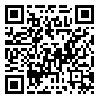1. Mahfoozpour S, Ainy E, Mobasheri F, Faramarzi A. [Patients' safety culture status among educational hospitals of Shahid Beheshti University of Medical Sciences in 2011.] Pajoohandeh J. 2012;17(3):134-41.
2. French J. Medical Errors and Patient Safety in Health Care. Canadian Journal of Medical Radiation Technology.2006; 37(4):9-13 [
DOI:10.1016/S0820-5930(09)60192-4]
3. Zali A. ["Still in the "registration system for medical error" not real / half percent of medical error statistics in Iran"]. Available from: www.yjc.ir/fa/news/4668018. Accessed February 12, 2014.
4. Mirzaei M, Khatony A, Safari Faramani R, Sepahvand E. [Prevalence, Types of Medication errors and Barriers to Reporting Errors by Nurses in an Educational Hospital in Kermanshah.] Hayat. 2014;19(3):28-37.
5. Seidi M, Zardosht R. [Survey of Nurses' Viewpoints on Causes of Medicinal Errors and Barriers to Reporting in Pediatric Units in Hospitals of Mashhad University of Medical Sciences]. J Fasa Univ Med Sci. 2012;2(3):142–7.
6. Hughes CM, Lapane KL. Nurses' and nursing assistants' perceptions of patient safety culture in nursing homes. Int J Qual Health Care. 2006;18(4):281-6. [
DOI:10.1093/intqhc/mzl020] [
PMID]
7. Jolaee S, Hajibabaee F, Peyravi H, Haghani H. [Nursing medication errors and its relationship with work condition in Iran University of Medical Sciences.] Iranian Journal of Medical Ethics and History of Medicine. 2009;3(1):65-76.
8. Baghaei R, Nourani D, Khalkhali H, Pirnejad H. [Evaluating Patient Safety Culture in Personnel of Academic Hospitals in Urmia University of Medical Sciences in 2011]. Journal of Urmia Nursing & Midwifery Faculty. 2012;10(2).
9. Mirfakhr Aldini S H, Farid D, Sayadi Touranlou H. [Use of EFQM in analysis of organizational culture dimensions (Case Study: Yazd Health Care Institutions)]. Journal of Shahid Sadoughi Unversity of Medical Sciences and Health Services.2010; 17(2):30-42.
10. Nasiripour AA, Raeisi P, Hedayati P. [The Relationship between Organizational Cultures and Employees Productivity in Ecucayional Hospital of Iran University Medical Sciences]. Journal of Health Administration. 2009.12(35):17-24.
11. Hoseini Sh, Yarmohamadian MH, Ajami S. [The Relationship between organizational culture and organizational maturity of staff in Isfahan Medical University Hospitals]. Journal of Hospital. 2009; 8(2).37-44.
12. El-Jardali F, Dimassi H, Jamal D, Jaafar M, Hemadeh N. Predictors and outcomes of patient safety culture in hospitals. BMC Health Serv Res. 2011;11(1):45. [
DOI:10.1186/1472-6963-11-45] [
PMID] [
PMCID]
13. Laschinger HKS, Leiter MP. The impact of nursing work environments on patient safety outcomes: The mediating role of burnout engagement. J Nurs Adm. 2006;36(5):259-67. [
DOI:10.1097/00005110-200605000-00019]
14. Aiken LH, Clarke SP, Sloane DM, Lake ET, Cheney T. Effects of hospital care environment on patient mortality and nurse outcomes. J Nurs Adm. 2008;38(5):223-9 [
DOI:10.1097/01.NNA.0000312773.42352.d7] [
PMID] [
PMCID]
15. Singla AK, Kitch BT, Weissman JS, Campbell EG. Assessing patient safety culture: a review and synthesis of the measurement tools. J Patient Saf. 2006;2(3):105-15. [
DOI:10.1097/01.jps.0000235388.39149.5a]
16. Moghri J, Ghanbarnezhad A, Moghri M, Rahimi Forooshani A, Akbari Sari A, Arab M. [Validation of Farsi version of hospital survey on patient Safety culture questionnaire, using confirmatory factor analysis method]. Hospital. 2012;11(2):19-30.
17. Rezapoor A, Tanoomand Khoushehmehr A, Bayat R, Arabloo J, Rezapoor Z. [Study of patients' safety culture in Selected Training hospitals affiliated whith Tehran university of medical sciences.] Hospital. 2012;11(2):55-64.
18. Alahmadi H. Assessment of patient safety culture in Saudi Arabian hospitals. Qual Saf Health Care. 2010;19(5):1-5. [
DOI:10.1136/qshc.2009.033258]
19. Bodur S, Filiz E. Validity and reliability of Turkish version of "Hospital Survey on Patient Safety Culture" and perception of patient safety in public hospitals in Turkey. BMC Health Serv Res. 2010; 10:28. [
DOI:10.1186/1472-6963-10-28] [
PMID] [
PMCID]
20. Chen I-C, Li H-H. Measuring patient safety culture in Taiwan using the Hospital Survey on Patient Safety Culture (HSOPSC). BMC Health Serv Res. 2010;10(1):152. [
DOI:10.1186/1472-6963-10-152] [
PMID] [
PMCID]
21. Hellings J, Schrooten W, Klazinga N, Vleugels A. Challenging patient safety culture: survey results. Int J Health Care Qual Assur. 2007;20(7):620-32. [
DOI:10.1108/09526860710822752] [
PMID]
22. Smits M, Christiaans-Dingelhoff I, Wagner C, van der Wal G, Groenewegen PP. The psychometric properties of the'Hospital Survey on Patient Safety Culture'in Dutch hospitals. BMC Health Serv Res. 2008;8(1):230. [
DOI:10.1186/1472-6963-8-230] [
PMID] [
PMCID]
23. Sorra J, Famolaro T, Dyer N, et al. Hospital Survey on Patient Safety Culture: 2009 Comparative Database Report.Rockville, MD: AHRQ Publication.No.10-0026; 2009.
24. Nasiripour A.A, Raeissi P, Tabibi S.J, Keikavoosi Arani L. [Hidden threats inducing medical errors in Tehran public hospitals]. Journal of Hormozgan University of Medical Sciences. 2011; 15(2):152-62.
25. Dehghan nayeri N, Nazari AA, Salsali M, Ahmadi F. [Wok force role in nursing productivity: qualitative research]. Hayat. 2006; 12(3):5-15.
26. Rostami H, Montazam H, Ghagramanian A, Mirghafoorvand M.[nurses' and patients ' viewpoint about patient education barriers]. Scientific Journal of Hamadan Nursing & Midwifery Faculty.2010; 18(1):50-5.
27. Sharifi S, Mohamad Alizade S. [Attitudes and Perceived Barriers to Carry Out Research among Hospital Nurse Administrator in hospitals of Kerman]. I J N. 2009; 59(22):51-9.
28. Burns N, Grove. K. The practice of nursing research : conduct, critique and utilization. 5th ed. Philadelphia: WB. Saunders Company; 2005






